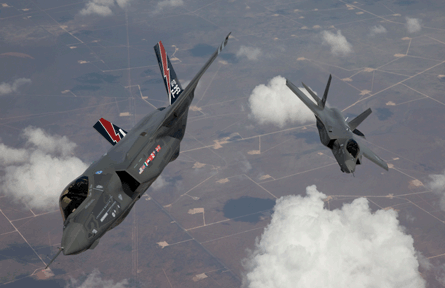An internal report predicts the Lockheed Martin F-35A conventional take-off and landing (CTOL) variant is falling short on a key performance requirement, forcing programme officials to consider a range of aircraft modifications to fix the problem.
Combat radius, the maximum distance of an out-bound leg with a full load of weapons and fuel, has dropped to 1,080km (584nm) for the F-35A, according to a leaked copy of the 2010 F-35 selection acquisition report (SAR).
That falls slightly below the specification for a minimum combat radius of 1,091km, one of seven mandatory “key performance parameters” that apply to the CTOL variant, the 31 December report states.
 |
|---|
© Lockheed Martin |
The SAR report shows combat radius for the other two F-35 variants has also declined, but remain above the threshold mandated by Lockheed's development contract.
The CTOL variant was originally expected to exceed the minimum combat radius by 185km, flying almost 1,280km one-way before needing to return to base or refuel in-flight.
But the number has been falling for several years and dropped by 41.8km this year based on a set of new assumptions.
The F-35's propulsion and avionics are running at higher temperatures than expected. To compensate, more bleed air from the Pratt & Whitney F135 engine is used for cooling, but this reduced propulsion efficiency and shortened range by 19.3km, according to sources familiar with the design issues. Another 16.1km of range was lost by new estimates about the aircraft's actual fuel capacity. Finally, the weight and drag of the aircraft's electro-optical targeting system was factored into the F-35's performance calculations, further reducing range by 6.4km.
As a result, the programme office is considering “realistic aircraft modifications to add fuel capacity” in an effort to meet the requirement, according to the SAR report.
One simple change under review is a software tweak that would maximise the amount of fuel taken onboard during in-flight refuelling. Another relatively simple fix is to raise shut-off valves higher inside the fuel tank to create slightly more capacity, a source said, adding: "That gets you back a lot of the fuel that you need to recover" to meet the range mandated by the contract.
A more complex solution also being considered is to install new fuel tanks in a small number of hollow spaces within the aircraft's structure.
But programme officials are also debating whether to change how the range of the F-35A is calculated, the source said. The equation does not include a buffer margin of 5% of fuel capacity, which is intended to be preserved through the end of the flight test period in 2016. Eliminating the buffer margin adds another 72.4km to the aircraft's combat radius, the source said.
Source: FlightGlobal.com




















